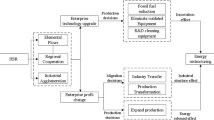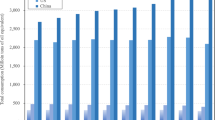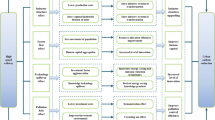Abstract
Improving energy efficiency is an important measure of environmental governance. At present, studies on the impact of high-speed rail on energy efficiency need to be further studied. This paper constructs panel data of 285 cities at prefecture-level and above in China from 2003 to 2017, and uses the difference-in-difference (DID) to study the impact of high-speed railway on urban energy efficiency. Based on the theories of “factor flow,” “knowledge spillover,” and “center-periphery,” this paper discusses the influence mechanism and heterogeneity of high-speed railway on energy efficiency. The empirical results show that high-speed railway can significantly improve energy efficiency, and the conclusion is still valid after parallel trend test, propensity score matching and difference-in-difference (PSM-DID) test, and instrumental variable method. The results remained true after a series of robustness tests. Mechanism analysis shows that high-speed railway can improve energy efficiency by promoting industrial structure upgrading, technological innovation, and market integration. Analysis of heterogeneity shows that the promotion effect of high-speed railway on energy efficiency is greater in central and western cities and core cities. This study provides useful enlightenment for optimizing China’s high-speed rail construction planning and seizing the opportunity of high-speed rail development to improve energy efficiency.



Similar content being viewed by others
Data availability
All data generated or analyzed during this study are included in this published article.
Notes
Approximate calculation process is as follows. The De-mean method proposed by Parsley and Wei (2001a, 2001b) was adopted to remove fixed effects related to commodity characteristics. Then obtain the relative price of the city portfolio, subtract the mean, calculate the relative variation of variance, take the average, and take the reciprocal. Limited by space, the specific calculation process is not shown. If necessary, please contact the corresponding author.
References
Acemoglu D, Moscona J, Robinson JA (2016) State capacity and American technology: evidence from the nineteenth century. Am Econ Rev 106(5):61–67
Ahlfeldt GM, Feddersen A (2018) From periphery to core: measuring agglomeration effects using high-speed rail. J Econ Geogr 18(2):355–390
Barbosa FC (2018) High speed rail technology: increased mobility with efficient capacity allocation and improved environmental performance. In ASME/IEEE joint rail conference (vol 50978, p V001T04A002). Am Soc Mech Eng. https://doi.org/10.1115/JRC2018-6137
Baron RM, Kenny DA (1986) The moderator–mediator variable distinction in social psychological research: conceptual, strategic, and statistical considerations. J Pers Soc Psychol 51(6):1173
Baum CF, Mark ES, Stillman S (2007) Enhanced routines for instrumental variables/GMM estimation and testing. Stata J 7(4):465–506
Bernstein S, Giroud X, Townsend RR (2016) The impact of venture capital monitoring. J Financ 71(4):1591–1622
Bosetti et al (2006) WITCH a world induced technical change hybrid model. Energy J 27:13–37. http://www.jstor.org/stable/23297044
Chen CL (2012) Reshaping Chinese space-economy through high-speed trains: opportunities and challenges. J Transp Geogr 22(C):312–316
Chen CL, Hall P (2011) The impacts of high-speed trains on British economic geography: a study of the UK’s InterCity 125/225 and its effects. J Transp Geogr 19(4):689–704
Chen Z, Haynes KE (2015) Impact of high speed rail on housing values: an observation from the Beijing-Shanghai line. J Transp Geogr 43:91–100
Cole MA, Elliott RJ (2003) Determining the trade–environment composition effect: the role of capital, labor and environmental regulations. J Environ Econ Manag 46(3):363–383
Dobruszkes F (2011) High-speed rail and air transport competition in Western Europe: a supply-oriented perspective. Transp Policy 18(6):870–879
Dong X, Zheng S, Kahn ME (2020) The role of transportation speed in facilitating high skilled teamwork across cities. J Urban Econ 115:103212
Duflo E, Pande R (2007) Dams. Q J Econ 122(2):601–646
Duranton G, Puga D (2005) From sectoral to functional urban specialisation. J Urban Econ 57(2):343–370
Faber B (2014) Trade integration, market size, and industrialization: evidence from China’s National Trunk Highway System. Rev Econ Stud 81(3):1046–1070
Feng X (2011) Optimization of target speeds of high-speed railway trains for traction energy saving and transport efficiency improvement. Energy Policy 39(12):7658–7665
Gao Y, Zheng J (2020) The impact of high-speed rail on innovation: an empirical test of the companion innovation hypothesis of transportation improvement with China’s manufacturing firms. World Dev 127:104838
Gines de Rus et al (2012) Economic analysis of high speed rail in Europe. Fundacion BBVA. https://xs.zidianzhan.net/books?hl=zh-CN&lr=&id=9gdeBAAAQBAJ&oi=fnd&pg=PA1&ots=QE2asS14Vq&sig=5KlfJpNs9TRKzAMI9yAjy665Dtw
Grossman GM, Rossi-Hansberg E (2008) Trading tasks: a simple theory of offshoring. Am Econ Rev 98(5):1978–1997
Guo K, Peng J (2022) Structural changes of secondary and tertiary industries and the quality of economic development. Finance Trade Econ 08:5–26 (in Chinese)
Gutiérrez J, González R, Gomez G (1996) The European high-speed train network: predicted effects on accessibility patterns. J Transp Geogr 4(4):227–238
Hanley D, Li J, Wu M (2022) High-speed railways and collaborative innovation. Reg Sci Urban Econ 93:103717
Hsieh CT, Klenow PJ (2009) Misallocation and manufacturing TFP in China and India. Q J Econ 124(4):1403–1448
Huang Y, Wang Y (2020) How does high-speed railway affect green innovation efficiency? A perspective of innovation factor mobility. J Clean Prod 265:121623
Jaffe AB, Trajtenberg M, Henderson R (1993) Geographic localization of knowledge spillovers as evidenced by patent citations. Q J Econ 108(3):577–598
Jia R, Nie H (2017) Decentralization, collusion, and coal mine deaths. Rev Econ Stat 99(1):105–118
Jong JC, Schonfeld P (2003) An evolutionary model for simultaneously optimizing three-dimensional highway alignments. Transp Res Part B: Methodol 37(2):107–128
Judd CM, Kenny DA (1981) Process analysis: estimating mediation in treatment evaluations. Eval Rev 5(5):602–619
Keeble D, Tyler P (1995) Enterprising behaviour and the urban-rural shift. Urban Studies 32(6):975–997
Kemfert C, Truong T (2007) Impact assessment of emissions stabilization scenarios with and without induced technological change. Energy Policy 35(11):5337–5345
Komikado H, Morikawa S, Bhatt A, Kato H (2021) High-speed rail, inter-regional accessibility, and regional innovation: evidence from Japan. Technol Forecast Soc Chang 167:120697
Krugman P (1980) Scale economies, product differentiation, and the pattern of trade. Am Econ Rev 70(5):950–959
Li X, Huang B, Li R, Zhang Y (2016) Exploring the impact of high speed railways on the spatial redistribution of economic activities-Yangtze River Delta urban agglomeration as a case study. J Transp Geogr 57:194–206
Li X, Cheng Z (2022) Does high-speed rail improve urban carbon emission efficiency in China? Socio-Econ Plan Sci 101308. https://doi.org/10.1016/j.seps.2022.101308
Lin Y (2017) Travel costs and urban specialization patterns: evidence from China’s high-speed railway system. J Urban Econ 98:98–123
Lin BQ, Wang XZ, Du ZL (2021) Impact of environmental regulation on China’s industrial energy efficiency: an empirical study based on the data of micro-enterprises. J Xiamen Univ (04):30–42. (in Chinese). https://kns.cnki.net/kcms/detail/detail.aspx?dbcode=CJFD&dbname=CJFDLAST2021&filename=XMDS202104004&uniplatform=NZKPT&v=V2XfOAg8fHHu1DtAtmDmOB4LXunRXM4Gp8GvRcqDGw2ZH4qs66CwB2K3lCOyJkys
Lindmark M (2002) An EKC-pattern in historical perspective: carbon dioxide emissions, technology, fuel prices and growth in Sweden 1870–1997. Ecol Econ 42(1–2):333–347
List JA, Co CY (2000) The effects of environmental regulations on foreign direct investment. J Environ Econ Manag 40(1):1–20
Liu Y, Li Y (2017) High-speed rails and city economic growth in China. J Financ Res 18–33. (in Chinese). https://kns.cnki.net/kcms/detail/detail.aspx?dbcode=CJFD&dbname=CJFDLAST2018&filename=JRYJ201711002&uniplatform=NZKPT&v=vGFPy9GNQ-ugDfQyksw0cmf4JeXUNh-b0nCCfl8_G6ywUulwuvIJWDMMSJ-aOy9c
Liu M, Wang X (2020) Trends and influencing factors of spatial migration in China’s manufacturing industry: 2007–2017. Quant Tech Econ Res 03:26–46 (in Chinese)
Lu D (2016) High-speed rail metro planning strategy. Hefei University of Technology (in Chinese). https://kns.cnki.net/KCMS/detail/detail.aspx?dbname=CMFD201701&filename=1016282180.nh
Lyubich E, Shapiro J, Walker R (2018) Regulating mismeasured pollution: Implications of firm heterogeneity for environmental policy. In AEA Pap Proc 108:136–142
Meng X, Lin S, Zhu X (2018) The resource redistribution effect of high-speed rail stations on the economic growth of neighbouring regions: evidence from China. Transp Policy 68:178–191
Monzón A, Ortega E, López E (2013) Efficiency and spatial equity impacts of high-speed rail extensions in urban areas. Cities 30:18–30
Nepal KP (2013) Environmental impacts of proposed high speed rail in Australia. Deakin University. Chapter 456–474. https://hdl.handle.net/10536/DRO/DU:30055190
Parsley DC, Wei SJ (2001a) Explaining the border effect: the role of exchange rate variability, shipping costs, and geography. J Int Econ 55(1):87–105
Parsley DC, Wei SJ (2001b) Limiting currency volatility to stimulate goods market integration: a price based approach (no.w8468). National Bureau of Economic Research. https://www.nber.org/papers/w8468
Pasche M (2002) Technical progress, structural change, and the environmental Kuznets curve. Ecol Econ 42(3):381–389
Pol P (2008) HST stations and urban dynamics: experiences from four European cities. In Railway development (pp 59–77). Physica-Verlag HD. https://link.springer.com/chapter/10.1007/978-3-7908-1972-4_4
Porter ME, Van der Linde C (1995) Toward a new conception of the environment-competitiveness relationship. J Econ Perspect 9(4):97–118
Rosenbaum PR, Rubin DB (1985) Constructing a control group using multivariate matched sampling methods that incorporate the propensity score. Am Stat 39(1):33–38
Rouwendal J, Meijer E (2001) Preferences for housing, jobs, and commuting: a mixed logit analysis. J Reg Sci 41(3):475–505
Ryzhenkov M (2016) Resource misallocation and manufacturing productivity: the case of Ukraine. J Comp Econ 44(1):41–55
Shao S, Tian Z, Yang L (2017) High-speed rail and urban service industry agglomeration: Evidence from China’s Yangtze River Delta region. J Transp Geogr 64:174–183
Shirley C, Winston C (2004) Firm inventory behavior and the returns from highway infrastructure investments. J Urban Econ 55(2):398–415
Song M, Zhang G, Zeng W, Liu J, Fang K (2016) Railway transportation and environmental efficiency in China. Transp Res Part d: Transp Environ 48:488–498
Storper M, Venables AJ (2004) Buzz: face-to-face contact and the urban economy. J Econ Geogr 4(4):351–370
Tang H, Zhang J, Fan F, Wang Z (2022) High-speed rail, urban form, and regional innovation: a time-varying difference-in-differences approach. Technol Anal Strateg Manag 1–15. https://doi.org/10.1080/09537325.2022.2026322
Trianni A, Cagno E, Worrell E (2013) Innovation and adoption of energy efficient technologies: an exploratory analysis of Italian primary metal manufacturing SMEs. Energy Policy 61:430–440
Vickerman R (1997) High-speed rail in Europe: experience and issues for future development. Ann Reg Sci 31(1):21–38
Vickerman R (2015) High-speed rail and regional development: the case of intermediate stations. J Transp Geogr 42:157–165
Vickerman R (2018) Can high-speed rail have a transformative effect on the economy? Transp Policy 62:31–37
Wang J, Cai S (2020) The construction of high-speed railway and urban innovation capacity: Based on the perspective of knowledge Spillover. China Econ Rev 63:101539
Xie J, Zhang J, Sun K, Ni S, Chen D (2021) Passenger and energy-saving oriented train timetable and stop plan synchronization optimization model. Transp Res Part d: Transp Environ 98:102975
Yang X, Lin S, Li Y, He M (2019a) Can high-speed rail reduce environmental pollution? Evidence from China. J Clean Prod 239:118135
Yang X, Lin S, Zhang J, He M (2019b) Does high-speed rail promote enterprises productivity? Evidence from China. J Adv Transp 2019. https://doi.org/10.1155/2019/1279489
Yang X, Zhang H, Lin S, Zhang J, Zeng J (2021) Does high-speed railway promote regional innovation growth or innovation convergence? Technol Soc 64:101472
Yang X, Zhang H, Li Y (2022) High-speed railway, factor flow and enterprise innovation efficiency: an empirical analysis on micro data. Socio-Econ Plan Sci 101305. https://doi.org/10.1016/j.seps.2022.101305
Yin W, Cai W (2001) The causes and governance of local market segmentation in China. Econ Res J (06):3-12+95. (in Chinese). https://kns.cnki.net/kcms/detail/detail.aspx?dbcode=CJFD&dbname=CJFD2001&filename=JJYJ200106000&uniplatform=NZKPT&v=5mhqxhGRHPwJzTNp3B4EtR0YlnCrpRpmQe-qzU1IyYX84iNZcvfwrtr-KOQdPT1a
Zhan S, Wang P, Wong SC, Lo SM (2022) Energy-efficient high-speed train rescheduling during a major disruption. Transp Res Part E: Logist Transp Rev 157:102492
Zhang M, Yu F, Zhong C, Lin F (2018) High-speed rail network, market access and enterprise’s productivity. China Ind Econ (05):137–156. (in Chinese). https://doi.org/10.19581/j.cnki.ciejournal.2018.05.008
Zhang H, Yan Q, Huang H (2019) Problems, impacts and solutions of China’s structural transformation from an international perspective. Chin Ind Econ 06:41–59 (in Chinese)
Zhang X, Wu W, Zhou Z, Yuan L (2020) Geographic proximity, information flows and corporate innovation: evidence from the high-speed rail construction in China. Pac Basin Financ J 61:101342
Zhang B, You S, Zhang L, Li D, Chen Y (2021) Energy-efficient speed profile optimization for high-speed railway considering neutral sections. IEEE Access 9:25090–25100
Zheng S, Kahn ME (2013) China’s bullet trains facilitate market integration and mitigate the cost of megacity growth. Proc Natl Acad Sci 110(14):E1248–E1253
Zhu Z, Lin X, Yang H (2021) Booming with speed: high-speed rail and regional green innovation. J Adv Transp 2021. https://doi.org/10.1155/2021/9705982
Funding
Work on this paper was supported by a grant from the Jiangxi University Humanities and Social Science Research Project (Grant No.JJ21107) and Jinggangshan University Doctoral Research Project (Grant No. JRB2201).
Author information
Authors and Affiliations
Contributions
Xuehui Yang: conceptualization, methodology, funding acquisition, writing — original draft. Yan Li: formal analysis, methodology, writing — review and editing. Le Liao: software, supervision, writing — review and editing.
Corresponding author
Ethics declarations
Ethics approval and consent to participate
Not applicable.
Consent for publication
Not applicable.
Competing interests
The authors declare no competing interests.
Additional information
Responsible Editor: Philippe Garrigues
Publisher's note
Springer Nature remains neutral with regard to jurisdictional claims in published maps and institutional affiliations.
Rights and permissions
Springer Nature or its licensor (e.g. a society or other partner) holds exclusive rights to this article under a publishing agreement with the author(s) or other rightsholder(s); author self-archiving of the accepted manuscript version of this article is solely governed by the terms of such publishing agreement and applicable law.
About this article
Cite this article
Yang, X., Li, Y. & Liao, L. The impact and mechanism of high-speed rail on energy efficiency: an empirical analysis based on 285 cities of China. Environ Sci Pollut Res 30, 23155–23172 (2023). https://doi.org/10.1007/s11356-022-23838-4
Received:
Accepted:
Published:
Issue Date:
DOI: https://doi.org/10.1007/s11356-022-23838-4




